oikos.earth*haltestelle: (…-)*
bilderzyklus 1 – 30 + 1

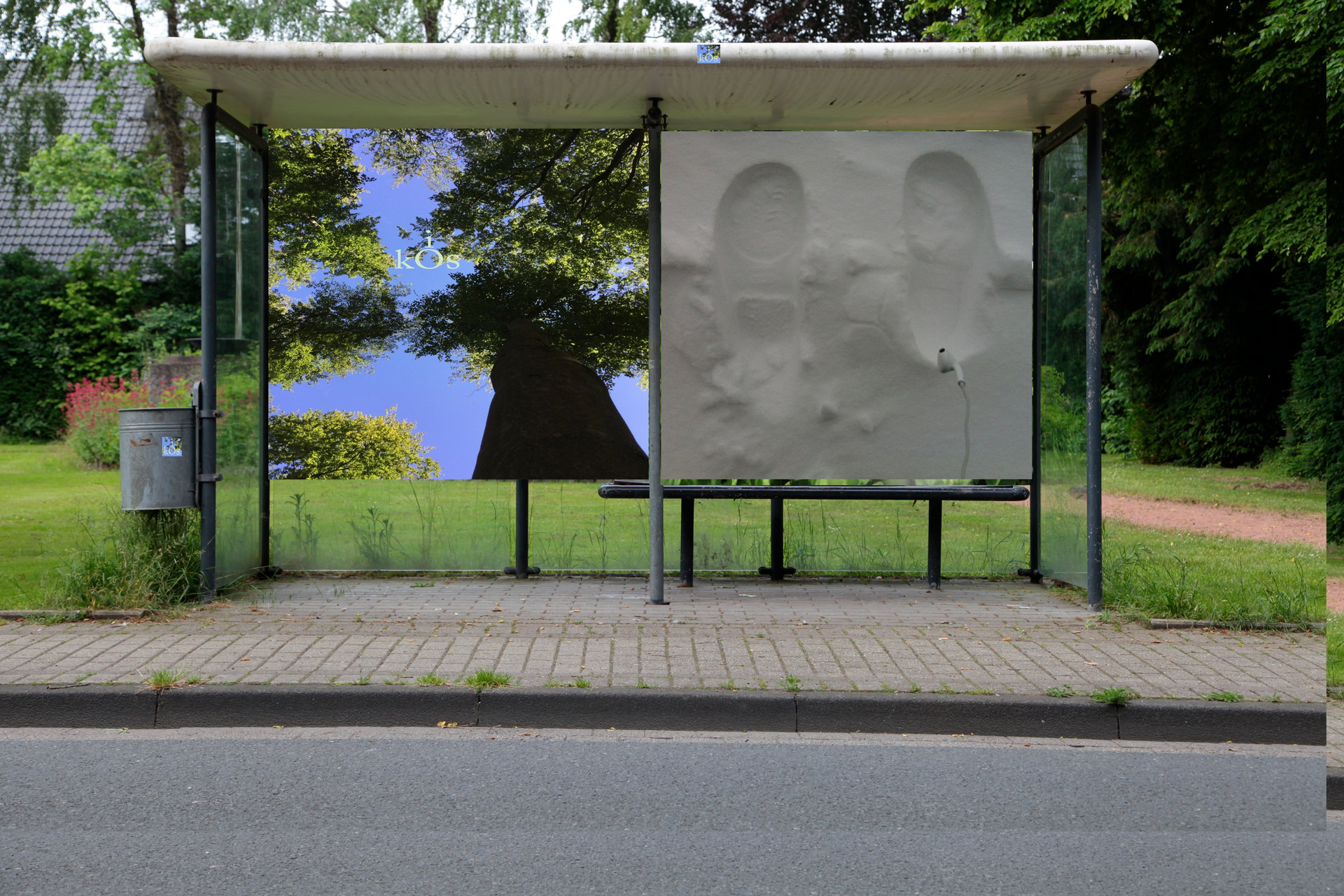



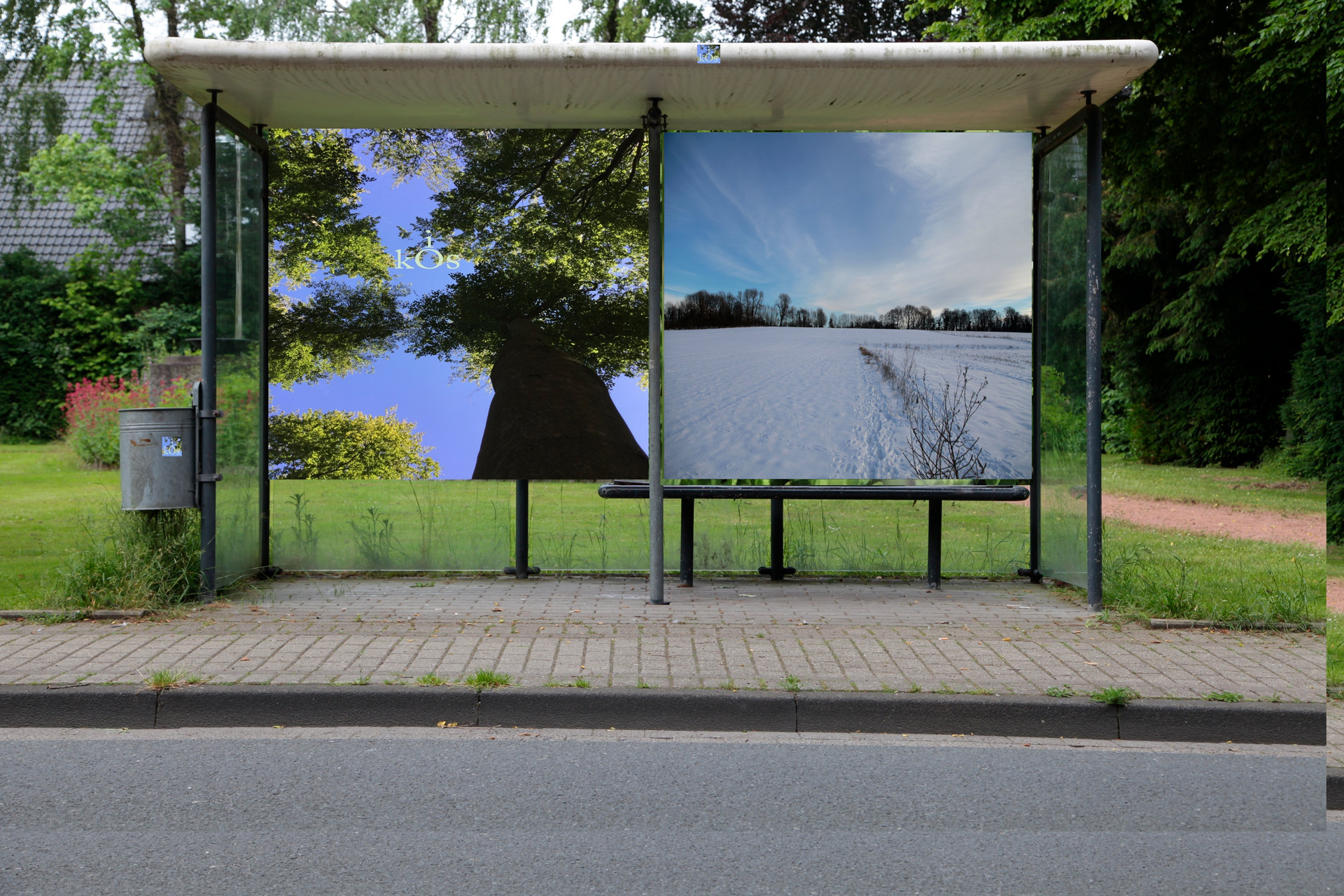
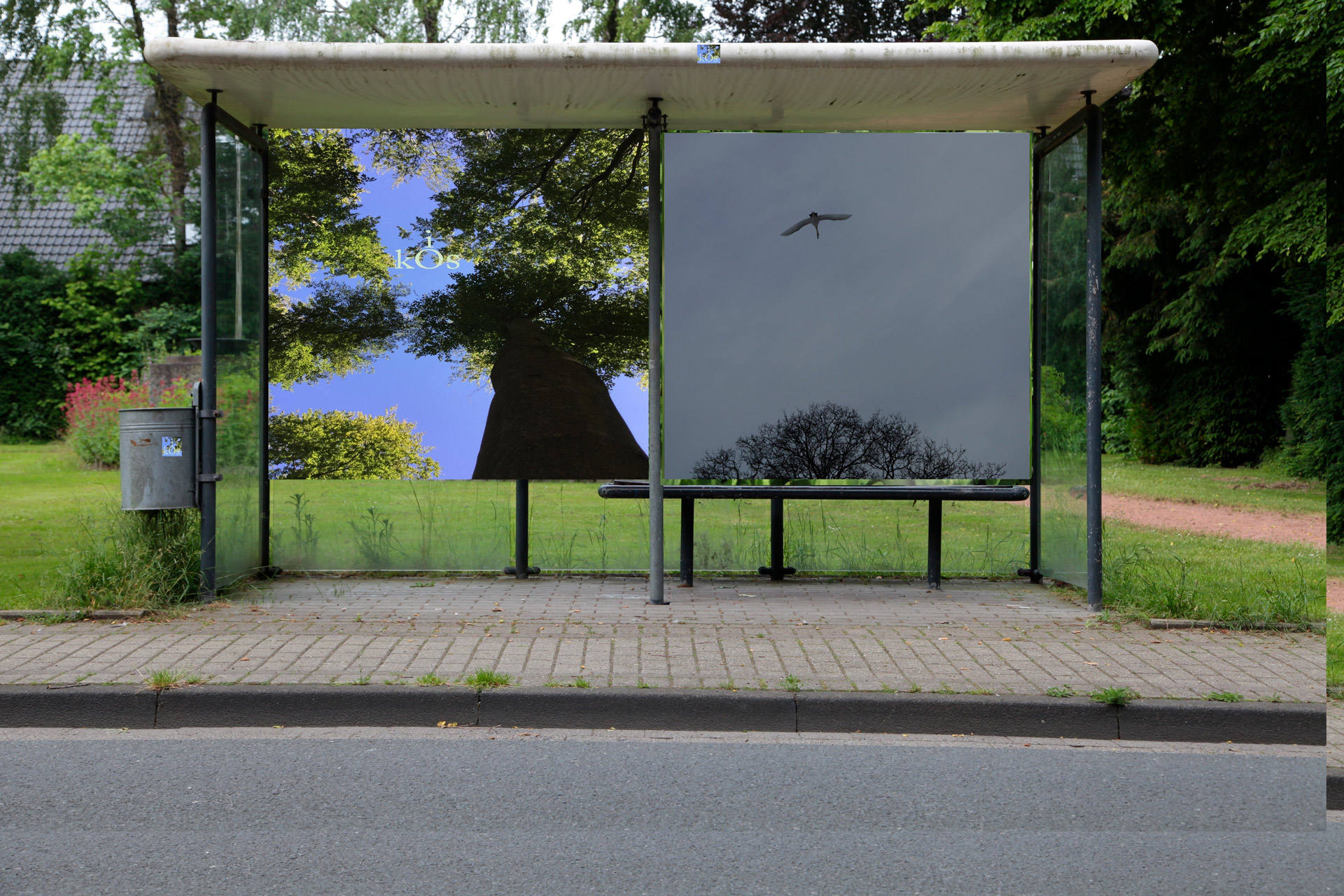
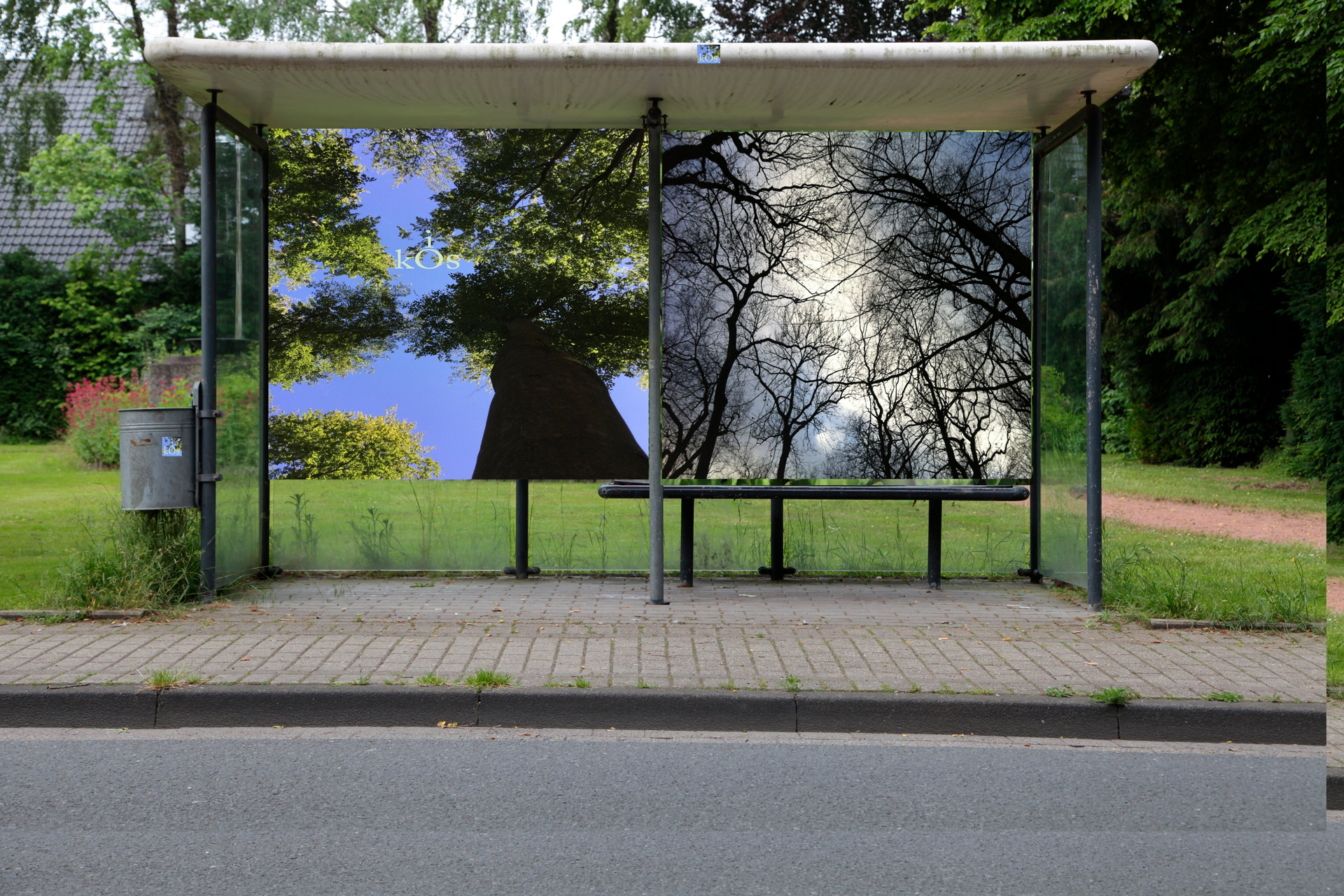
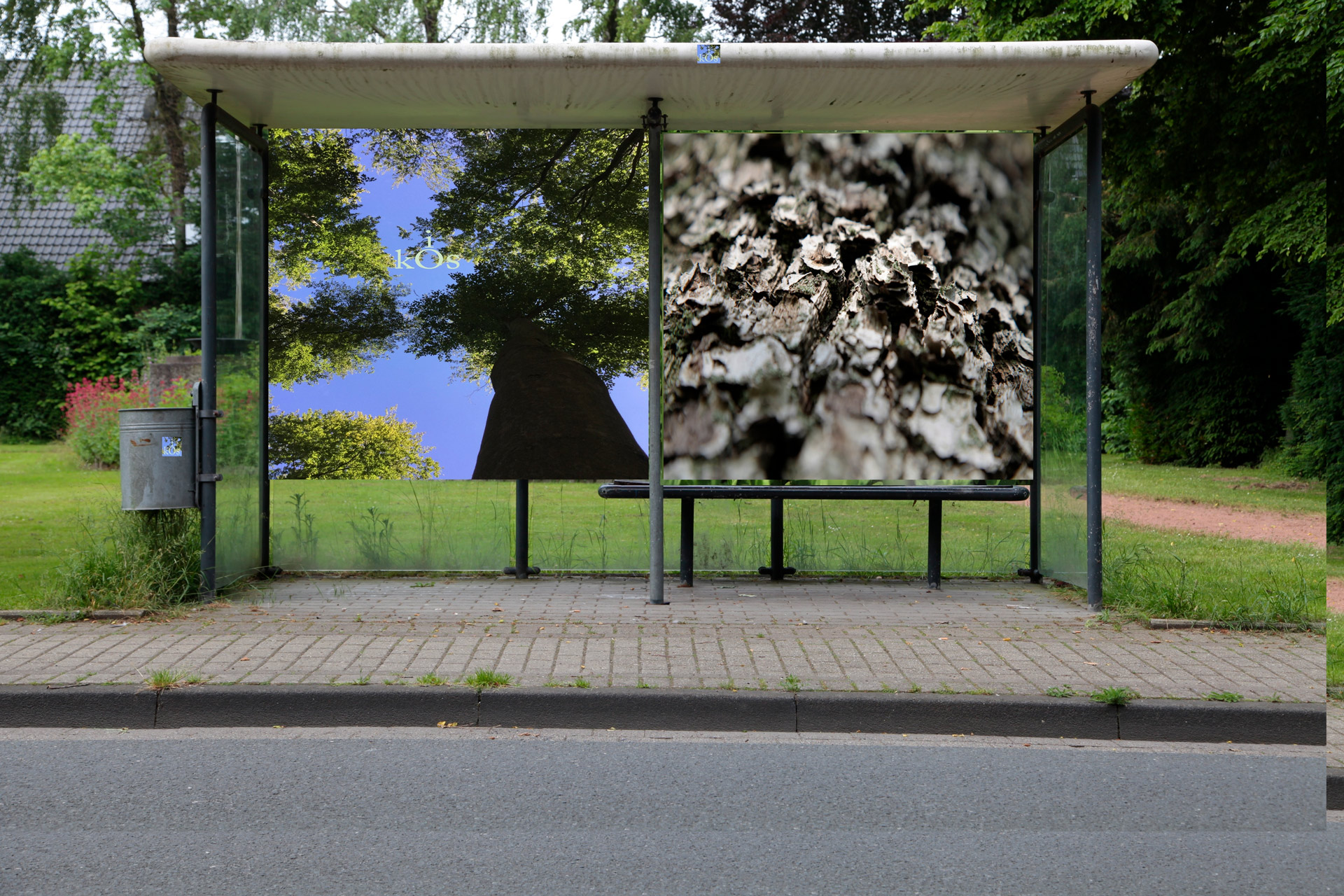



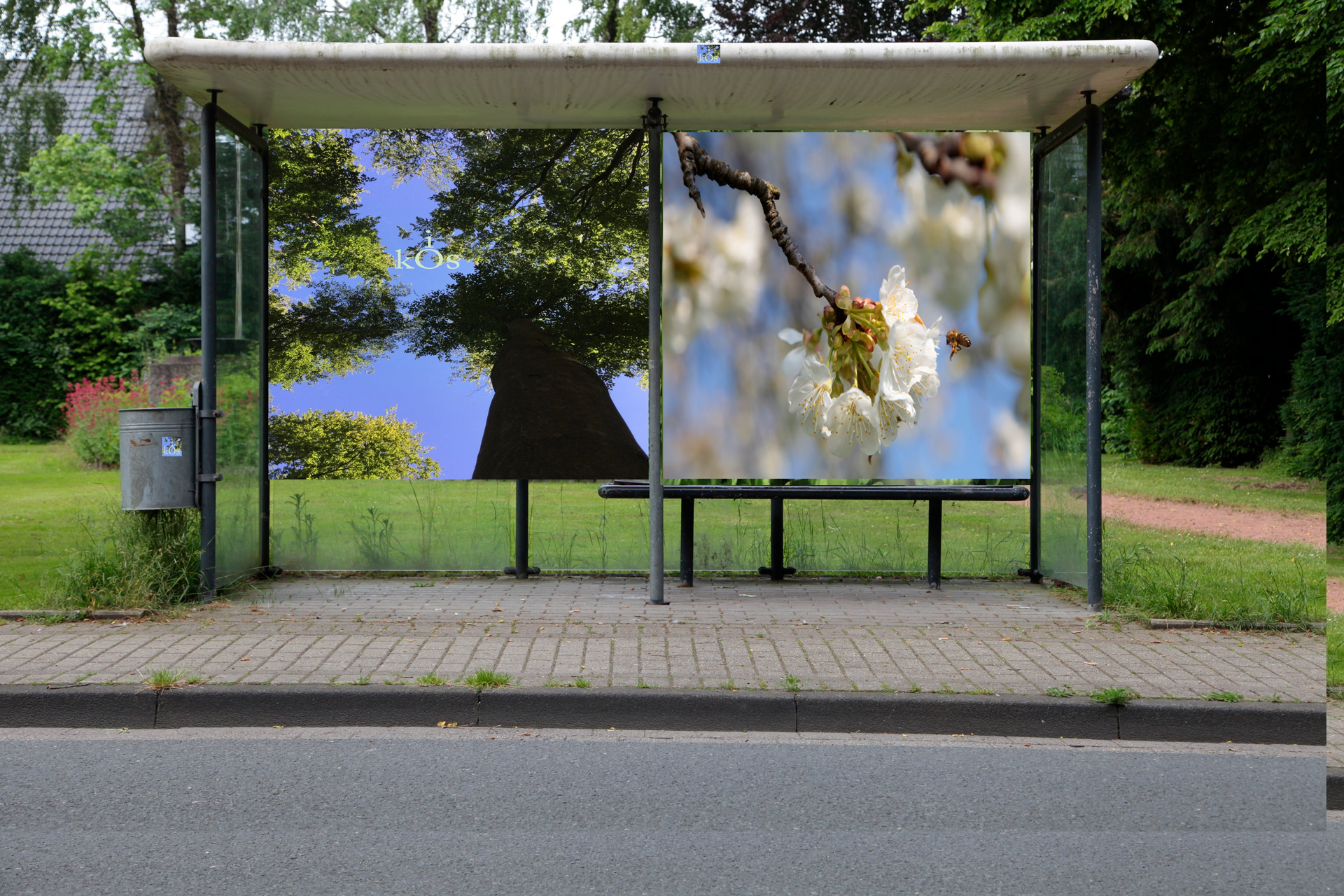




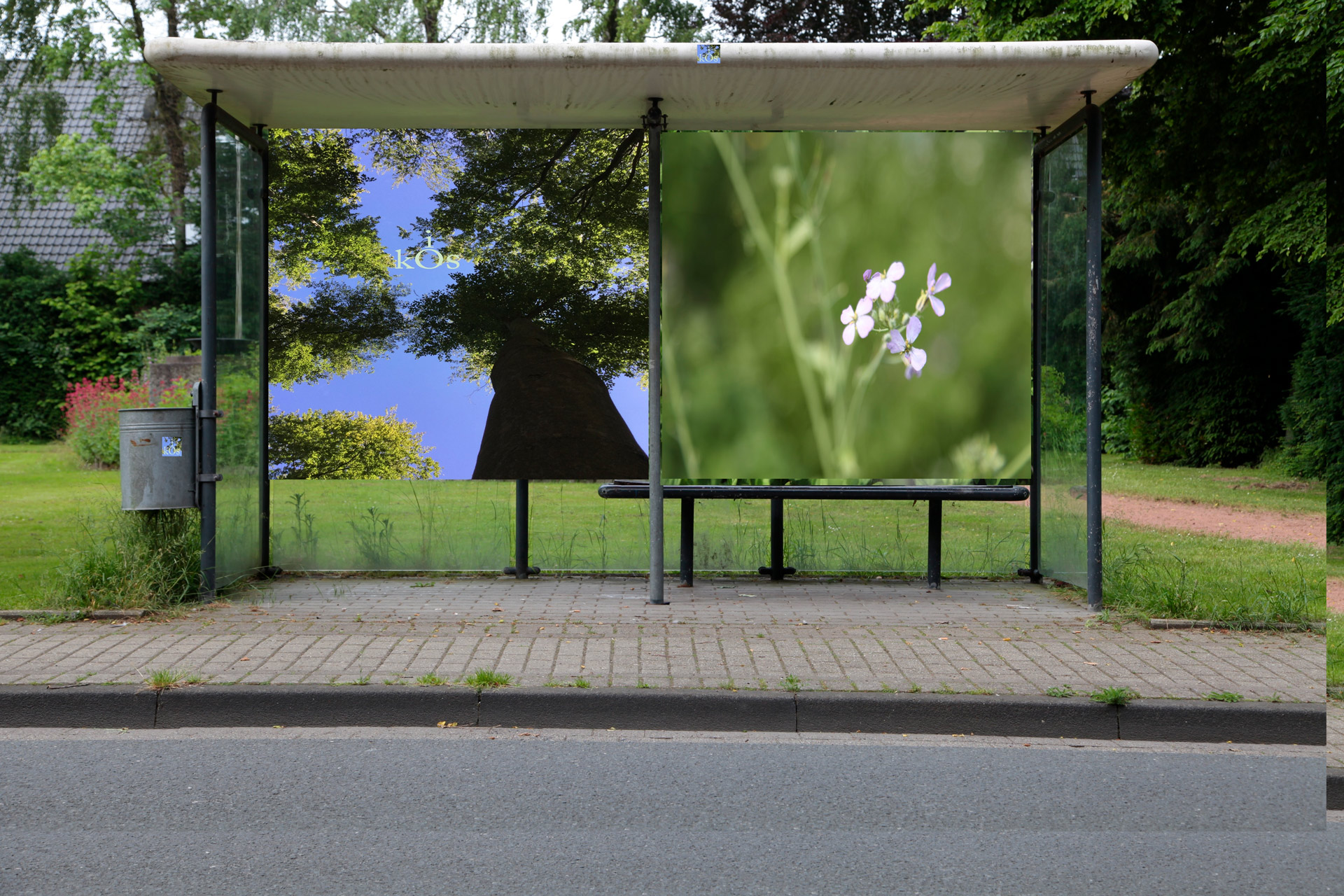


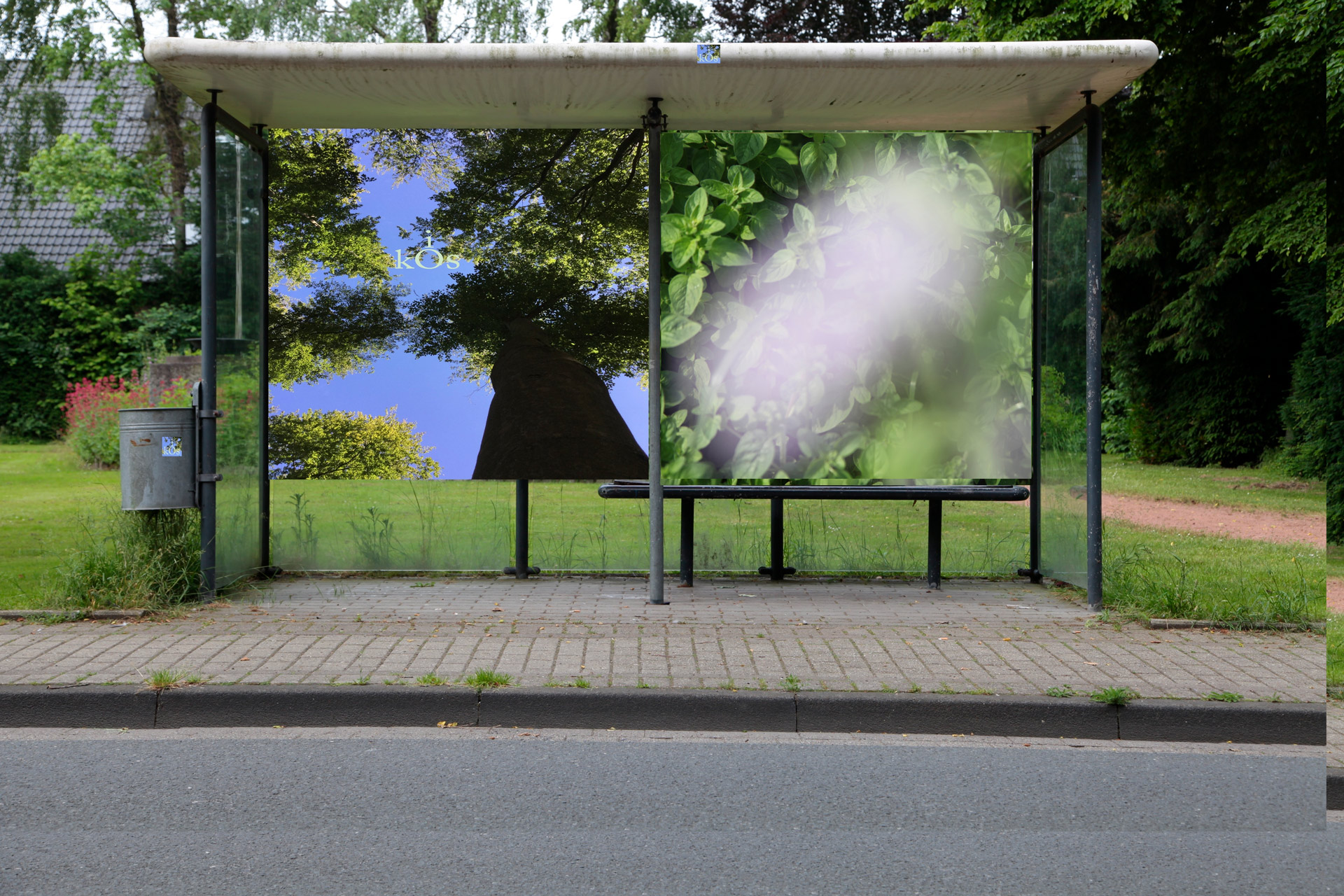

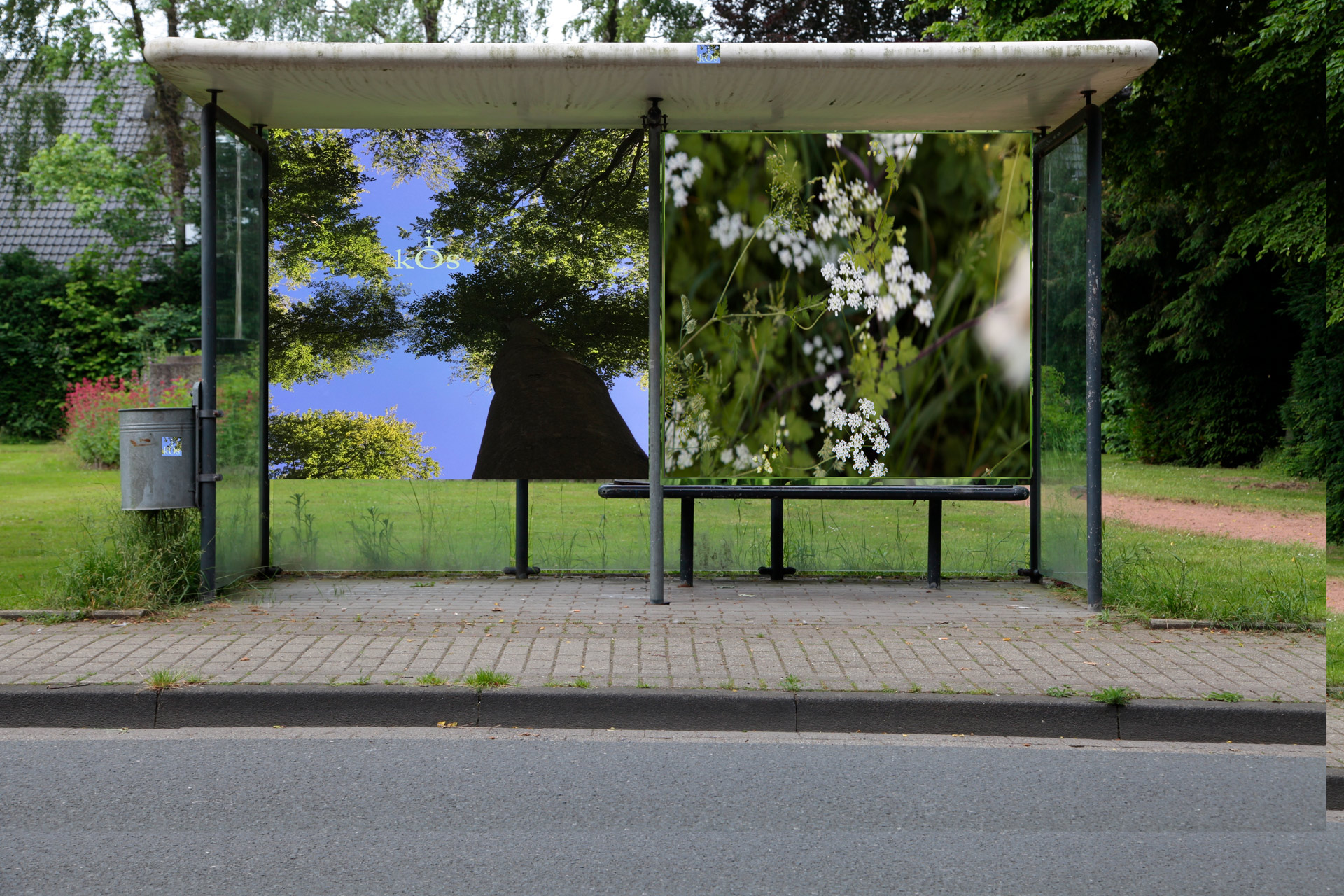


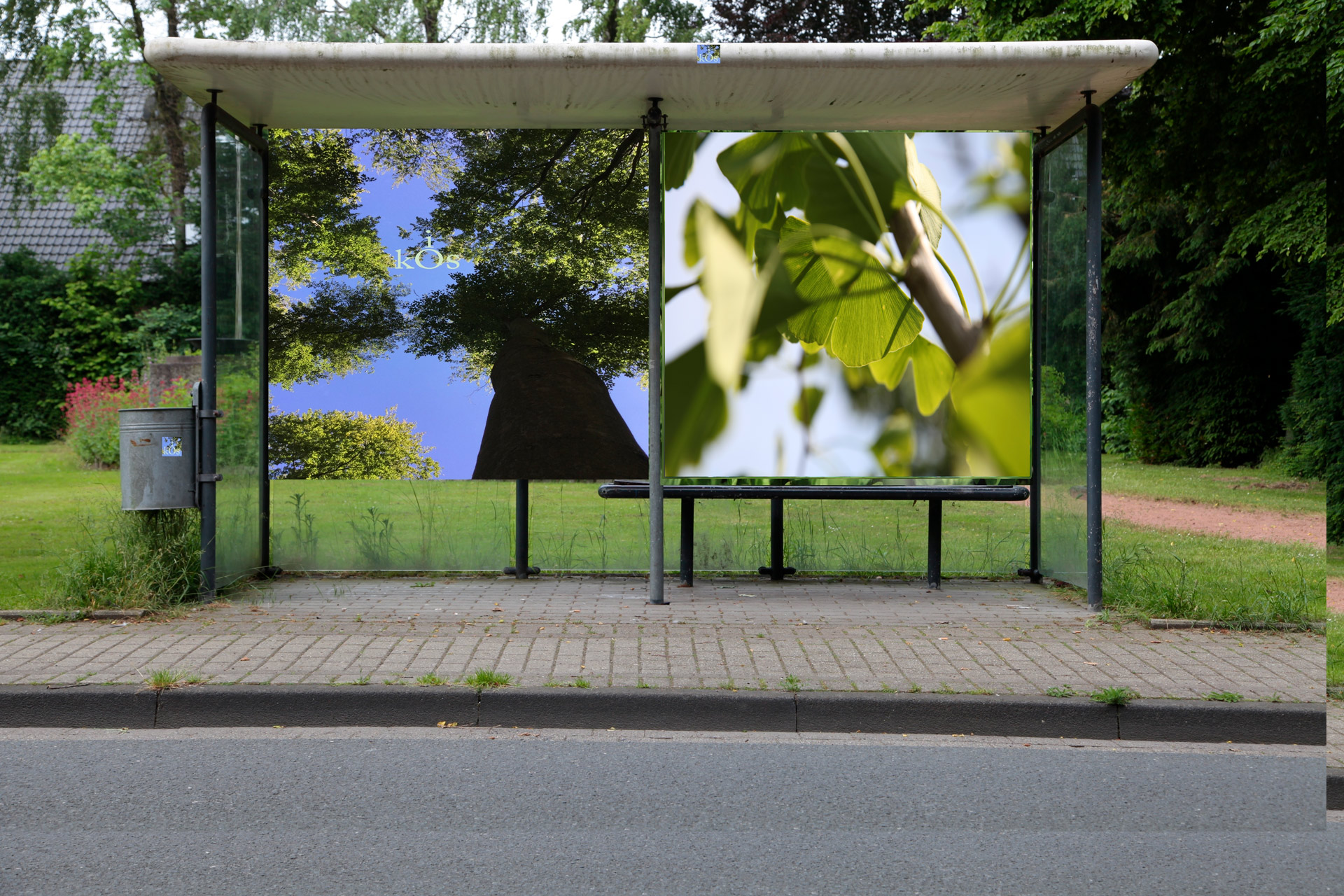






oikos1earth
intro
We differ from all other beings on this planet due to the fact we are the only ones who know about the dangerous microparticles, especially Covid19, which are invisible to the human eye and spread through the airs via aerosols.2 Due to the corona pandemic aerosols have literally been on everyone’s lips.
With my oikos-project I opened a fresh-air window onto a biospheric perception-space, recorded it during the eighteen month of intermittent lockdown in 2020-21, and continued to develop it further: focus. The artistic research-project oikos focusses on the present state of the biosphere3 in times of climate change:4 “…all life on this planet depends on photosynthesis…”5 Like other microparticles pollen is transported in aerosols, like microscopic space shuttles in the air. In climate science aerosols are being explored as the basis and trigger for cloud formation.6 With the dimension of forests the influence on climate and the resulting weather phenomena grows in relation to this.7
Within the forest8 atmosphere9 it is terpenes2 which influence temperature and humidity or climate. Terpenes are secondary aerosols, volatile substances with their own fragrance which exclusively appear in the forest or in essential oils perceived nasally through the oldest human orientation sense.
For instance, the fragrance of conifers opens up a time window of approximately 300 million years. These sensory perception spaces can be experienced, and generate synergies following the principle of Shinrin-Yoku – The Art and Science of Forest-Bathing.10
On oikos.earth an atlas forms the entrée, and invites us with visual inspiration to travel in time into the planetary space of life using biospherical recordings: breath in, breath out, in mindfulness11 of the time window through which the gaze is conditioned for the biosphere and its temporarily visible forest-climate-perception-spaces. The atlas on oikos.earth opens up a visual level on which recorded moments, programmed in a random algorithm, become visible: sequences of my individual recorded pictures – in various depths of field and foci – are continually combined anew: seasons, weather, times of the day and (visually perceptible) temperatures appear in an airy juxtaposition and invite an individual tour of discovery.
installation – sensory intervention: besides the atlas, the bildzyklus 1 – 30 + 1 can be seen as an image-generating installation – a sensorial intervention under the ongoing project-title oikos.earth*haltestelle: (…–)* . Two oikos paper objects were created as an oikos prelude under the title biosphere, – they show a tree from a low perspective with my specially developed oikos-logo and a white paper object, both crumpled to the size of the globe in picture 1 of bildzyklus 1 – 30 + 1. The oikos double-picture cycle forms an activating poetic narrative by showing the biosphere via 30 + 1 pictorial compositions which, in a sequence of pointed titles concretizes, dissolves, echoes and opens up perceptual (imaginative) spaces in which to sense and imagine. In the double-picture arrangement of bildzyklus 1 - 30 + 1 the left-hand picture continually presents the oikos logo I created in a treetop from a low perspective, while on the right a steady image-fluctuation takes place and thereby a cinematic moment evolves. From the picture titles the pictorial and imaginative spaces rise in a circular motion: biosphere – cloud – pollen in plant flowers, including:
bild 13 oikos.earth*haltestelle: cirrus floccus prunus
bild 14 oikos.earth*haltestelle: cumulus radiatus helianthus annuus
bild 15 oikos.earth*haltestelle: cumulus fibratus ranunculus acris
bild 16 oikos.earth*haltestelle: cumulus translucidus calendulus
bild 22 oikos.earth*haltestelle: cumulus translucidus origanum
bild 30 oikos.earth*haltestelle: rainbow*(red+orange+yellow+green+blue+indigo+violet)
bild 31 shows the bus stop dorfstrasse ehrenmal: the transparent glass shelter in a 1970s design – revealing a view of the memorial –.
Oikos12Earth13Haltestelle14: Biosphere15
1 oikos (ancient greek οἶκος)
“(…) economy and ecology both originate from the ancient Greek term οἶκος (…).” infotext-particle* quoted from : Alt, Franz. Der Klima-Appell des Dalai-Lama an die Welt, mit Franz Alt – Schützt unsere Umwelt. Benevento Elsbethen, 2020, page 98 (Engl. transl. A.M.)
oikos = house (e)
“(…) this practical opening matters for the being of the art of the “eco” (…). The root “eco” is to be understood in its originally Greek meaning: oikos, it means house, home ownership, habitat, natural environment (…).” infotext-particle* quoted from: Guattari, Felix. Les trois écologies. Éditions Galilée, Paris 1989. Deutsche Ausgabe: Guattari, Felix. Die drei Ökologien. Passagen forum. Hsg. Peter Engelmann, Passagen Verlag 1994, page 49, p. 74 ibid. 11 (Engl. transl. A.M.)
house
“(…) our house is on fire. (…) the solution to the climate crisis is the most vast and complex challenge homo sapiens has ever been confronted with (…). we must stop our emissions of greenhouse gas (…).” infotext-particle* quoted from: Greta Thunbergs speech at World Economic Forum in Davos 2019, on January 25, in: Thunberg, Greta. Ich will, dass ihr in Panik geratet. Meine Reden zum Klimaschutz. Fischer Frankfurt am Main, 6. Auflage 2019, page 43-48 (Engl. transl. A.M.)
2 aerosols
“(…) take the form of fluent or solid floating particles in the atmosphere involved in cloud formation. Natural aerosols include mineral dust and salt crystals above the ocean, biological aerosols include pollen, bacteria, spurs, viruses** and volcanic sulphate aerosols. Trees emit terpenes (…) which can lead to the formation of cloud seeds (…).” infotext-particle* quoted from: Brönnimann, Stefan. Klimatologie. 1.Auflage, Haupt Bern, CH 2018, page 58 [**added to the quote authorized by Prof.Dr. Stefan Brönnimann – in correspondence with A.M. on 2021-07-12] (Engl. transl. A.M.)
3 biosphere (gr. bios = life, gr. sphaira = sphere)
“(…) the biosphere, life on earth, is part of the climate system (…) and this is why it is in a just as especially intense interaction with the atmosphere (…) as the pedosphere (ground). (…) Basic building blocks of life include cells, tissue and organs, each composed from organic-chemical unions. (…) Apart from very primitive forms of life (i.e. viruses, unicellular organisms), the biosphere is divided into plants (vegetation = flora), animals (fauna) and human beings (part of the biosphere or separate anthroposphere) (…).” infotext-particle* quoted from: Schönwiese, Christian-Dietrich. Klimatologie, 5. Auflage, Verlag Eugen Ulmer Stuttgart, 2020, page 257-258 (Engl. transl. A.M.)
biosphere
“(…) all existence is only (a) self-revelation of one essential nature (…)“. infotext-particle* quoted from: Schelling, Friedrich Wilhelm Josef. Aphorismen über die Naturphilosophie. Philosophische Bibliothek, Felix Meiner Verlag, Hamburg 2018, S. 66/VII. First edition in 1806: Aphorismen über die Naturphilosophie. Der Naturphilosophie Erster oder allgemeiner Theil. (Beschluss), in: Jahrbücher der Medicin als Wissenschaft, Bd.II, H.2 (1806), page 3-36 (Engl. transl. A.M.)
biosphere
“ (...) without todays approximately 20.000 species of bees (…) neither a cherry blossom in Japan nor an apple blossom in Hamburgs Altem Land nor flower meadows wouldn’t exist at all (...)”. infotext-particle* quoted from: Eitner, Kerstin und Katja Morgenthaler. Die Bienen. Eine Liebeserklärung. greenpeace magazin edition, Hamburg 2015, page 7 (Engl. transl. A.M.)
biosphere
“(…) like (…) birds we balanced on our branches (…) the age of trees was reaching out to a human life span (…) for millions of people were (…) his big, shiny eyes, which were looking up into a blue sky, only connected with one single word (…): hope (…)”. infotext-particle* quoted from: Lunde, Maja. Bienes Historie. H. Aschehoug & Co., Oslo 2015. Deutschsprachige Ausgabe: Lunde, Maja. Die Geschichte der Bienen. Btb Random House GmbH, München 2017, S. 7, page 508 (Engl. transl. A.M.)
biosphere
“(…) we can begin something, because we are beginnings in order to be beginners (…).” infotext-particle* quoted from: Arendt, Hannah. The Freedom to be free, in: Thinking without a Banister: Essays in Understanding, Vol.11, Schocken Books New York 2018. Deutsche Erstausgabe: Arendt, Hannah. Die Freiheit, frei zu sein. Mit einem Nachwort von Thomas Meyer. dtv Verlagsgruppe, München 2018, page 37 (Essay by H.A. for her published book On Revolution in 1963) (Engl. transl. A.M.)
biosphere
“(…) ´they (the plants and animals) are, what we have been (…)´. never before I’ve touched the earth so intensively (…).” infotext-particle* quoted from: Han, Byung-Chul. Lob der Erde. Eine Reise in den Garten. Mit Illustrationen von Isabella Gresser. Ullstein Verlag, Berlin 2018, page 66 ff. (integrated by B.-C.H. quote from: Friedrich Schiller.`Über das Glück´) (Engl. transl. A.M.)
biosphere
“(…) the next revolution: sustainability (...)” infotext-particle* quoted from: Medows, Donella with Jørgen Randers and Dennis Meadows. Limits to Growth – The 30-Year Update. Chelsea Green Publishing Company, White River Junstion, Vermont USA 2004. Deutsche Erstausgabe: Grenzen des Wachstums – Das 30-Jahre-Update. Signal zum Kurswechsel. 2006. 6. Auflage mit einem Geleitwort von Ernst Ulrich von Weizsäcker, Ehrenpräsident des Club of Rome. S. Hirzel Verlag Stuttgart 2020, page 279-294 (Engl. transl. A.M.)
biosphere
“(…) future-oriented education is value-oriented. Values represent the wisdom of centuries (…).” infotext-particle* quoted from: Wir sind dran. Was wir ändern müssen, wenn wir bleiben wollen – Club of Rome: Der grosse Bericht erstellt für das 50-jährige Bestehen des Club of Rome 2018. Ernst Ulrich von Weizsäcker und Anders Wijkman u.a.. Erstausgabe Güthersloher Verlagshaus, Gütersloh 2017. Zweitausgabe Pantheon Random House GmbH, München 2019, page 372 fff. (Engl. transl. A.M.)
biosphere
“(…) I am usually in a lecture hall at the university, expounding about botany and ecology––trying, in short, to explain to my students how Skywoman’s gardens, known by some as “global ecosystems”, function (…).” infotext-particle* quoted from: Kimmerer, Robin W.: Braiding Sweetgrass. Indigenous Wisdom, Scientific Knowledge and the Teaching of Plants. First published by Milkweed Editions 2013. Published in Penguin Books Random House UK, London, 2020, page 6
4 climate-change
“(…) a temperature increase of several degrees (…) will certainly have radical consequences for the biosphere (…).” infotext-particle* quoted from: Rahmstorf, Stefan, und Hans-Joachim Schellnhuber. Der Klimawandel: Diagnose, Prognose, Therapie. 8., vollständig überarbeitete und aktualisierte Auflage, Originalausgabe. C.H. Beck, München 2018, page 72 (Engl. transl. A.M.)
Potsdam Institute for Climate Impact Research (PIK) www.pik-potsdam.de
climate-change
“(…) to account for carbon absorption caused by livestock-motivated deforestation (…), where rainforests normally stores at least 200 tons of carbon per hectare. Where forest is replaced by moderately degraded grassland, the tonnage of carbon stored per hectare is reduced to 8. (…)”. infotext-particle* quoted from: Foer, Jonathan Safran. WE ARE THE WEATHER. Saving the Planet begins at Breakfast. Penguin Random House UK: Hamish Hamilton, London 2019, page 230-231
climate-change
“ (...) black carbon is really dangerous for the climate (…) black carbon consists of particles, which absorb sunlight, then this warmth is directly emitted into the air (…) it descends on (Arctic) surfaces of snow and ice, and let them melt down faster (...)”. infotext-particle* quoted from: Mark Jacobson, Head of the Atmosphere-Energy-Program, Stanford University, in: Sea Blind – Umweltkatastrophe auf den Weltmeeren. Documentary movie by Sarah Robertson and Bernice Notenboom, WDR 2017 (Engl. transl. A.M.)
climate-change
“(…) such a Green New Deal connects the idea of justice with the idea of fighting the climate-change (…).” infotext-particle* quoted from: Klein, Naomi. How to Change Everything. The Young Human’s Guide to Protecting the Planet and Each Other. Atheneum Books, New York 2021. Deutschsprachige Ausgabe: Klein, Naomi. How to Change Everything. Wie wir alles ändern können und die Zukunft retten. Hoffmann und Campe Verlag, Hamburg 2021, page 213 (Engl. transl. A.M.)
climate-change
“(…) in reality a regeneration of our soils and woodlands is the most efficient way to fight the warming of the earth (…).”infotext-particle* quoted from: Pelluchon, Corine. Les Lumières à l’âge du vivant, © Editions du Seuil 2021. Deutschsprachige Ausgabe: Pelluchon, Corine. Das Zeitalter des Lebendigen. Eine neue Philosophie der Aufklärung. wbg Academic, Darmstadt 2021, page 153 (Engl. transl. A.M.)
5 photosynthesis
“(…) photosynthesis (ancient Greek φῶς phō̂s, English ‘light’ and σύνθεσις sýnthesis, Engl. ‘synthesis’…) is a process used by plants and other organisms to convert light energy into chemical energy (…). It is operated by plants, algae and several bacteria. (…).” infotext-particle* quoted from: Wikipedia (Engl. transl. A.M.)
photosynthesis
“(…) all life on this planet depends on photosynthesis (…).” infotext-particle* quoted from: Francis Hallé, biologist a. botanist, in: Il était une forêt. Documentary movie by Luc Jacquet, F 2013 (Engl. transl. A.M.)
6 cloud
“(…) a cloud is an accumulation of diminutive particles of water-droplets or ice-molecules, which additionally can contain salt-crystals, pollen, fume- or dust molecules (…).” infotext-particle* quoted from: Hamblin, Richard. Welche Wolke ist das? Franck-Kosmos Stuttgart, 2009, page 155 (Engl. transl. A.M.)
7 weather
“(…) the term ‘weather’ describes the physical condition in the atmosphere at a particular moment in time (…) at a particular location (…).” infotext-particle* quoted from: Wetter und Klima – Deutscher Wetterdienst - Glossar – Wetter. www.dwd.de (Engl. transl. A.M.)
weather
“(…) though the larger the forests are the more they influence the climate and with it the weather as well (…).” infotext-particle* quoted from: Otto, Friederike, Wütendes Wetter. Auf der Suche nach den Schuldigen für Hitzewellen, Hochwasser und Stürme. Unter Mitarbeit von Benjamin von Brackel. Ullstein Berlin, 2019, page 81 (Engl. transl. A.M.)
8 forest
“(…) all forms of life like fungi, bacteria, plants and animals have to be there to build a real forest. Large plants build the structure of a forest. Trees by themselves do not define the term forest: (…) it is a network of relations between different living beings (…).” infotext-particle* quoted from: Francis Hallé, biologist a. botanist, in: Il était une forêt. Documentary movie by Luc Jacquet, F 2013 (Engl. transl. A.M.)
forest
“(…) trees communicate together, trees care for each other and lovingly cultivate their next generation, old and diseased neighbours; trees have sensations, spirits, a brain (…).” infotext-particle* quoted from: Wohlleben, Peter. Das geheime Leben der Bäume. Ludwig Verlag, München 2015 (Engl. transl. A.M.)
forest
“(…) the mycorrhiza network – ‘wood wide web’ – runs closely beneath the surface of the forest soil (…) the tree root systems are the brain of the forest (…).” infotext-particle* quoted from: Suzanne Simard, Forest scientist with the team of the University of British Columbia Canada and Peter Wohlleben, forester, in: Intelligente Bäume. Documentary movie by Julia Dordel and Guido Tölke, 2017 (Engl. transl. A.M.)
forest
“(…) The moving cloud fades away, and I smell the aroma of the mushroom (…).” infotext-particle* quoted from: Lowenhaupt Tsing, Anna. The Mushroom at the End of the World. On the Possibility of Life in Capitalist Ruins. Princeton University Press, Princeton and Oxford 2015, Prologue. Autum Aroma 1, page 7, page 290 ibid.7., page 291 ibid.10. (Quoted in Okamura Toshihisa. Matsutake no bunkashi [the cultural history of Matsutake], Tokyo: Yama to Keikokusha, 2005)
forest
“(…) in a handful of earth there are more living beings than there are human beings on the planet. (…) When we protect nature, we protect ourselves (…).” infotext-particle* quoted from: Peter Wohlleben, in: Das geheime Leben der Bäume. Documentary movie by Jörg Adolph, 2020 (Engl. transl. A.M.)
forest
22 years ago forests were covering a quarter of the surface of the world, today only a fifth. In a further 22 years, in the year 2000, it will be anticipated only a sixth of the land area will be covered by forests. Probably the world’s forest stand around the year 2020 will level off to a seventh of the land area.* (...).” infotext-particle* quoted from: Wälder und Forstwesen, in: Global 2000. The Global 2000 Report to the President. Publ. Council on Environmental Quality and the US-Ministry of Foreign Affairs. Gerald O. Barney, Study Director, Washington, U.S. Government Printing Office, 1980. American original edition publisher Blue Angel/Zweitausendeins. Deutsche Übersetzung u. Ausgabe bei Zweitausendeins, Frankfurt a.M., 1980, page 313 fff. (Engl. transl. A.M.)
forest
“(…) The tree is perhaps the symbol of the cosmos (…); plants need our protection (…); we humans cannot exist without them and would not survive their disappearance (…).” infotext-particle* quoted from: Hallé, Francis. Éloge de la Plante, pour une Nouvelle Biologie. Eiditions du Seuil, Paris 1999. Engl. Translation: Hallé, Francis. In Praise of Plants, by Timber Press, Inc. London, 2002, page 38
9 atmosphere
“(…) atmosphere (ancient Greek τμός atmós, English ‘mist’, ‘dust’, ‘air’ and σφαῖρα sphaira, English ‘globe’) stands for: earth atmosphere, the gasiform shell of the earth. Atmosphere (astronomy), the gasiform shell around a celestial body. Physical atmosphere, historical unit of measurement of pressure (…).” infotext-particle* quoted from: Wikipedia (Engl. transl. A.M.)
10 shinrin-yoku (Japanese) = forest-bathing (English)
“(…) shinrin yoku is like a bridge. By opening our senses, it bridges the gap between us and the natural world. (…) The art of forest-bathing is the art of connecting with nature through our senses (…), biophilia, from the Greek, meaning `love of life and the living world´(…). We have a biological need to connect with it. (…) Forests contain 80 per cent of the world’s land biodiversity and are home to 60,000 different types of trees. They store more than 1 trillion tonnes of carbon, twice the amount found in the atmosphere (…).” infotext-particle* quoted from: Li, Qing. Shinrin-Yoku – The Art and Science of Forest-Bathing. Penguin Books Random House UK, London 2018, page 14-15, p. 117, p. 275 ff.
11 mindfulness
“(…) mindfulness means, to be in this here and now – not only physically, but also mentally. (…) Being mindful means to stop evaluation and to focus on that which is currently beyond thought (…).” infotext-particle* quoted from: www.planet-wissen.de (Engl. transl. A.M.)
awareness = mindfulness
“(…) awareness and meditation work synergistically to heal us and help us to be our best (...). After the ancient Taoist wisdom through practice, that which is hidden becomes subtle. Then, that which is subtle becomes obvious’ (…).”infotext-particle* quoted from: Lane, Josh. Conscious Nature – The Art and Neuroscience of Meditating in Nature. New York USA, printed by BoD in Norderstedt 2019, page 13
awareness = mindfulness
“(…) some states of reality are parts of the world and at the same time parts of the self (...)“. infotext-particle* quoted from: Metzinger, Thomas. BEING NO ONE. The Self-Model Theory of Subjectivity. Massachachusetts Institute of Technology, 2003. A Bradford Book. The MIT Press. Cambridge, Massachusetts and London, England. First MIT Press paperback edition, 2004, page 314
awareness = mindfulness
“(…) we all swim permanently in an unconscious ocean of interbodyality, the ‘zwischenkörperlichkeit’, and mirror each other (...)“. infotext-particle* quoted from: Metzinger, Thomas. Der Ego Tunnel. Berlin Verlag GmbH, 2009, page 243 (Engl. transl. A.M.)
awareness = mindfulness
“(…) effortful mindfulness‘ means effortlessly awareness following the tibetan meditation teaching (...)“. infotext-particle* quoted from: Thomas Metzinger in: Autonom? – die menschliche Gedankenwelt. Wie wir eine Bewusstseinskultur entwickeln können, darüber spricht Jürgen Wiebicke mit dem Philosophen Thomas Metzinger. WDR 5, Das philosophische Radio, 19.07.2021. 55:00 Min. WDR 5 (Engl. transl. A.M.)
12 ibid. 1.
13 earth
“(…) the third planet in the orbit of the sun and on the whole the fifth largest. The earth is the only known planet where there is life. The earth is also the only planet where water does exist in fluent form, which covers more than 70 percent of the earth-surface (…).” infotext-particle* quoted from: https://www.thefreedictionary.com/earth
14 haltestelle (German) = (bus)stop (English)
“(…) a place on a line of local public transport, which is (…) stopped by public transport by plan or at least regular driven by (…).” infotext-particle* quoted from: wikipedia
15 ibid. 3.
*infotext-particle: own word-creation, inspired by floating particles – air-blob with pollen = *footnote with quoted information from text with bibliographical source-information and/or link
︎